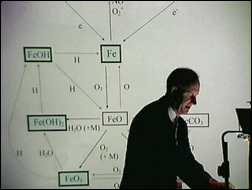|
Leonid MAC |
| home |
| View the shower |
| Mission Brief |
| Science Update |
| Media Brief |
| links |
LEONID DAILY NEWS: October 21, 2002

Dr. John Plane at COSPAR/World Space Congress special session on Leonid storms. COSPAR/WORLD SPACE CONGRESS HIGHLIGHTS.
A special session on "Meteor Induced Chemistry, Ablation Products, and Dust in the
Middle and Upper Atmosphere" was organized by Peter Jenniskens
as a joint COSPAR/IAC event at the
World Space Congress in Houston, TX, on October 16.
Hajime
Yano of ISAS, Japan, summarized results from the Leonid MAC Workshop and discussed the
satellite impact hazard issue.
Co-chair John Plane,
who studies the chemical reactions of iron atoms in
the upper atmosphere in laboratory conditions at the University of East Anglia,
discussed the role of meteoric
smoke in providing condensation nuclei for noctilucent clouds in the upper mesosphere,
forming sulphuric acid particles in the stratospheric layer, and
in fertilizing the Fe-deficient Southern Ocean. Frans Rietmeijer
of the University of New Mexico calculated that the expected middle-atmospheric carbon abundance is
a high C/Fe (at.) = 0.3 and C/Mg (at.) = 0.25.
John Zinn of
Los Alamos National Laboratory presented a model of meteor (train)
emission, predicting strong 760 nm emission of molecular oxygen, which may
provide insight into the recent detection of such emission in meteor afterglow.
Leonid MAC Instrument PI Mike Taylor of Utah
State University presented results on the ejection of small meteoroid fragments
from rapidly rotating meteoroids. Peter Jenniskens
discussed quantative data on meteor plasma temperatures and abundances
from 2001 Leonid MAC data and the latest results by Hans Stenbeak-Nielsen
on the peculiar shock wave in high frame-rate images.
S.P. Gupta of the Physical Research Laboratory at Ahmedabad
in India reported results from the first (and only) rocket experiment during the
Leonid storm of 1999. A possible detection of plasma wave occilations in the
frequency range of 2 kHz near 105 km altitude was made
at the peak of the 1999 Leonid storm on Nov 18
and (less strong) during a second flight on Nov. 20.
Finally, J.F. Carbary and coworkers of John
Hopkins University/APL presented further ultraviolet spectroscopic
data from a second Leonid spectrum observed by the MSX satellite (see
earlier result).
The spectrum of a bright fireball detected
in 1999 shows emissions of oxygen, nitrogen and hydrogen
at short wavelengths between 110 and 130 nm and strong Mg+ emission
at 280 nm, but only a weak Mg emission at 285 nm. Oct 21 - Highlights COSPAR/World Space Congress Aug 31 - First UV spectrum: Leonid from space 2001: Dec 11 - Shocking Leonid Dec 01 - Moon impacts Nov 26 - Near-IR persistent train emission Nov 24 - Results of near-real time flux measurements Nov 22 - Wowh! Optical meteor spectra 2000: Dec. 25 - Ursid shower circular IMO Dec. 24 - Ursid shows early release of sodium Dec. 23 - Ursid outburst confirmed Dec. 18 - Dec 22 Ursid outburst Nov. 20 - A bacterial fingerprint? Nov. 15 - HCN disappears mysteriously Nov. 14 - Meteor shower from space Nov. 13 - Organic fingerprint Nov. 12 - Train airglow chemistry Nov. 11 - Hard bits and persisting glows Nov. 10 - Meteoroid debris detected Nov. 09 - New meteor picture Nov. 08 - Spin city Nov. 07 - Meteors affect atmospheric chemistry Nov. 06 - Listen to this! Nov. 04 - Fear of heights? Nov. 03 - The pale (infra-red) dot Nov. 02 - Twin showers Nov. 01 - Leonids approaching Earth Oct. 31 - Prospects for Moon Impact Studies Oct. 30 - Comet dust crumbled less fine Today's news
| ||

